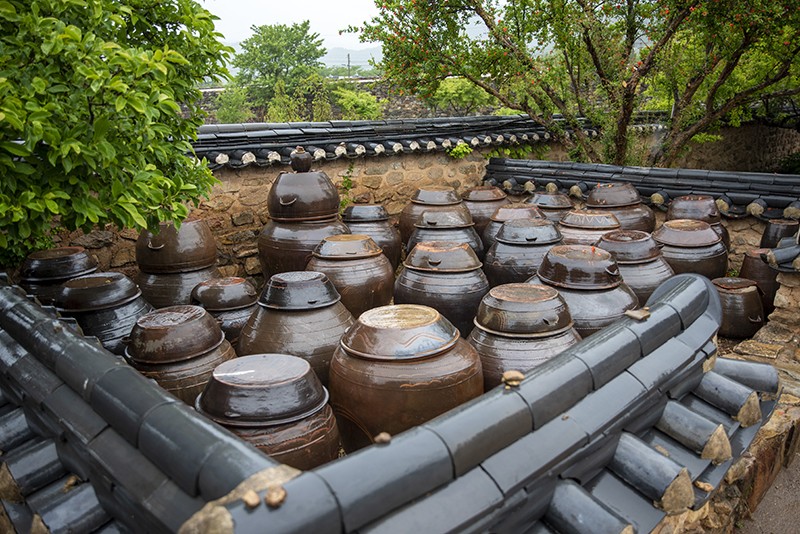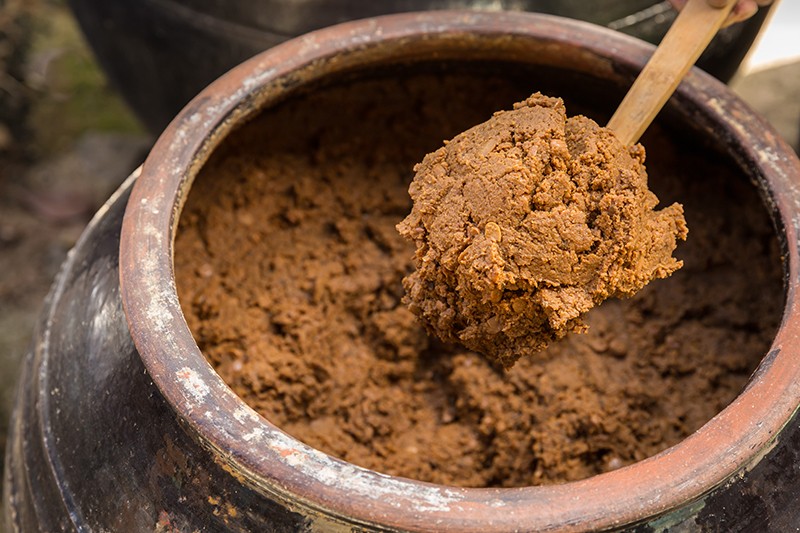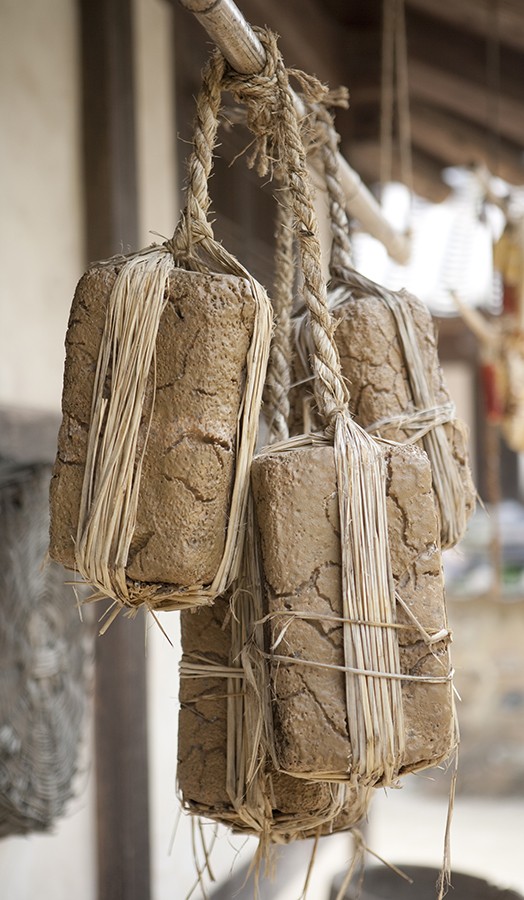한식 읽기 좋은 날
Vol 53. Korean Food from the Oceans and Rivers
Korea’s Millennia-old Jang Culture: Thinking about the Future of Sustainable Doenjang
Facts about HANSIK
Old doenjang (soybean paste) takes on a vast array of colors and flavors. We live in an age in which most people do not live in a setting that is conducive to making doenjang at home. Nevertheless, we cannot lose sight of the infinite possibilities that lie within doenjang. We must think about sustainability and preservation—in other words, how to best preserve its rich flavors and many beneficial functions—so that the culture of doenjang can be passed down for many generations to come.
Article Yim Kyeongsook (president of KFPI) / Originally published in July issue of JoongAng Ilbo Cooking

Doenjang: from earthenware jars to the supermarket shelf
Doenjang, which is made by submerging meju (soybean blocks), removing the surface water, and using the chunks that remain, is the most basic seasoning of Korean food. It has a long history spanning several millennia. In the early years, it was a combination of soy sauce and doenjang, but after the Three Kingdoms Period, meju was used to make doenjang in the format that we know today.
Volume on the Western Wu of the Records of the Three Kingdoms, which was written in the third century by Chen Shou (233-297) of the Jin dynasty, mentions the people of Goguryeo and their finesse with making fermented foods. The part of the 12th-century historical text Memorabilia of the Three Kingdoms by Kim Busik on the third year (683) of King Sinmun mentions that jang was included in the gifts given by the daughter of Kim Heumwoon in her marriage to King Sinmun.
Even with this extensive history, what comes to mind for most people when they think about doenjang is rows of plastic containers that can be found in any supermarket or retail store. Until just several decades ago, albeit with differences in scale, every home had a jangdokdae, or a flat surface for keeping large earthenware jars filled with doenjang and other traditional jang. As this indicates, doenjang was made and consumed self-sufficiently by family units—a practice that is all but extinct today due to the proliferation of Western eating habits and multi-unit housing (e.g. apartments). Furthermore, the increase in nuclear family and single-person households is accelerating the decline of doenjang-making as the task of women who marry into jonggajip (clan head families) or a tidbit of long-lost history from, as the Korean saying goes, “when tigers used to smoke.”

The fascinating world of doenjang
Doenjang made in the traditional manner is an essential part of modern Korean meals, usually taking on different names and formats based on region, the person who made it, and/or time of year. When it is broken down by microorganisms, doenjang produces a brownish substance called melanoidine. Depending on multiple factors, the color can range from pale golden-yellow to dark brown. This attests to the sheer range of traditional jang, most of which are still consumed today.
Doenjang is categorized by ingredient and production method. There is mak doenjang, which is made by fermenting a mixture of meju and saltwater, after which the soy sauce is removed. Adding powdered meju and saltwater to the mak doenjang and then leaving it to ferment, or leaving doenjang made only with meju at room temperature for a long period of time, produces what is called tojang. There is also dambukjang, which is made by adding warm water to fermented meju powder and fermenting it for a short period, and jeupjang, which is made by mixing powdered meju with saltwater and vegetables (e.g. eggplant, cucumber) and fermenting the mixture for one week.
There are many other types of doenjang, including those made by steaming damp soybeans (as with rice cakes) and then fermenting them by covering with leaves (to help distribute the bacteria strain); adding kimchi soup after grinding meju; using biji (bean curd dregs) in lieu of meju; using boiled red beans and other types of beans; mixing beans and yeast during the “Period of Great Heat” (sambok); and pouring cooled boiled water over sliced meju, leaving for approximately 10 days, and then adding salt. As you can see, there is nowhere near enough room in this article to name every type of doenjang!
There are also doenjang that are defined by local color as opposed to ingredients. Local doenjang is also very diverse: there is ppamjang from the Gyeongsang Provinces, which is made by cutting meju into large pieces and then fermenting in cooled boiled saltwater; ppagaejang of the Chungcheong Provinces, which is made by mixing powdered meju with pepper flakes, salt, and soybean-boiled water; and garujang of Gangwon-do, which is made by mixing powdered meju with ground and steamed barley rice and then fermenting it in cooled boiled saltwater.
Another topic that people are increasingly interested in is the benefits of doenjang, which are as diverse as its types. Lecithin and saponin, substances in the soybean, improve brain function and lower blood cholesterol. They also prevent the formation of peroxide lipids and dementia and delay aging. Doenjang also restricts the creation of transaminase, an indicator of hepatoxicity, thereby improving the liver’s function. Donguibogam mentions that doenjang helps alleviate headaches accompanied by fever and chills by making the body sweat.

Doenjang goes global as a sauce
Increasing international awareness of the flavors and functions of doenjang has dovetailed with an increased interest in Korean food in general to produce “fusion Korean food,” some of which is based on doenjang. There are many countries in which doenjang is used to create diverse sauces that even people who are unfamiliar with Korean food can enjoy.
Balsamic doenjang dressing, which is made by mixing doenjang with balsamic vinegar, maesil (plum) syrup, and olive oil, perfectly complements tomatoes, onions, chicory, and other salad ingredients. There is also doenjang mayonnaise, which includes cooking wine and sesame oil and is best consumed with oil-rich meat and fish (beef brisket, salmon, etc.) because it balances the greasiness and adds a savory kick. Doenjang is a good companion for meat and fish dishes in general due to its elimination of the unpleasant odors of meat and fish and ability to add more dimension to the flavors.
The need to preserve Korea’s jang culture
To preserve the culture of jang, which offers both health benefits and delicious flavors, and its methods of production that have been part of the Korean table for so long, the KFPI offers funding for cultural programs on jang-making. Specifically, funding is given to institutions and organizations related to jang for hosting cultural or educational events/programs: programs funded thus far have covered everything from how to make meju to how to separate soy sauce from doenjang and recipes for doenjang-based foods.
From 2019 until the present, the KFPI has funded 14 organizations, whose programs have offered interactive experiences of and education on jang-making for a total of 1,800 people. There is also a program conducted at kindergartens and elementary schools that encourages Koreans to become familiar with jang and teaches the importance of preserving its traditions from a young age.
The KFPI is also consistently participating in efforts to register “Jang Damgeugi (Korean Sauce and Paste Making” as a UNESCO Intangible Cultural Heritage. Together with the Cultural Heritage Administration, it filled out the relevant application form, which the Cultural Heritage Administration submitted to UNESCO’s secretariat on March 30. Currently, the KFPI is waiting for UNESCO to announce its decision, which is expected to be posted in December 2024.
Furthermore, for the past three years, the KFPI has conducted the Jang Culture Forum, which compares the cultural values embedded in the jang culture of East Asia with that of Korea. The forum also provides an invaluable opportunity to reflect on the value of traditional jang culture as an intangible heritage of humanity as well as ways in which this value can be interpreted for future generations.
The KFPI will continue supporting educational programs that convey the merits, characteristics, and production methods of doenjang to the next generation and help with the registration of jang culture as a UNESCO Intangible Cultural Heritage. It is time for us, as a society, to think about the sustainability of doenjang and jang culture to ensure that this tradition can continue to be passed down and citizens can become more knowledgeable about this very important aspect of their culinary culture.











